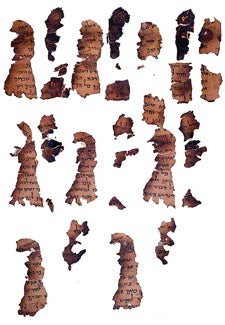Digital Humanities at Its Finest
For Bruce Zuckerman, a picture is worth a lot more than a thousand words. As an authority on ancient Semitic and biblical texts, he can tell you how a letter worn off the surface of parchment — or even the leg of a letter — can change the meaning of an entire passage and our understanding of history along with it.
As a doctoral student in the 1970s, nothing was more frustrating to him than a fuzzy photo of a hard to read inscription. That’s when he had a revelation: You can’t expect scholars to produce research-quality images or photographers to know what features of an ancient language to highlight during image documentation. But what if you could combine their skills?
“If you have this disconnect between the person doing the documentation and the person doing the analysis, it’s a real problem,” said Zuckerman, professor of religion and linguistics at the USC Dornsife. “You have to know what you’re looking for.”
Delicate, Ancient Texts
For the past 30 years, Zuckerman and his team of researchers have dedicated themselves to preserving cultural history. As director of USC’s West Semitic Research Project, he and his team have documented delicate, ancient texts and objects and distributed their images to thousands of scholars around the world.
Zuckerman has pioneered the use of digital photography to reveal the ancient past. One technique he and the project team has excelled in is Reflectance Transformation Imaging (RTI), which can capture a world of microscopic detail, producing images that are literally clearer than anything seen by the human eye. RTI photography can highlight the hair follicles left on an animal hide used as parchment or the way ink is pooled in minute spikes in the folds of its skin. Zuckerman can use it to see each ink stroke a scribe made — and even show you the mistakes they corrected.
These are more than just photos. The data-rich images can preserve what a text looks like lit from a multitude of angles. Scholars in 44 countries regularly log on to Inscriptifact, an archival database where thousands of these interactive digital objects can be accessed. There, researchers can move the lighting around in real time with a click of their mouse, snapping shapes and letters into sharp and dynamic relief.

These fragments from Qumran belong to literature called the Testament or Farewell Discourse, which represent the “last words” of a famous person in Israel to their descendants or followers. The messages predict the future, warn of dangers to come, and give instructions on behavior. Photo by Bruce and Kenneth Zuckerman, West Semitic Research, in collaboration with the Princeton Theological Seminary. Courtesy of Department of Antiquities, Jordan.
Placing Scholarship at the Forefront
The West Semitic Research Project has recently taken a new step: a grant program for training academics with RTI kits customized for fieldwork.
The kits include color and infrared cameras, high-resolution lenses, and an array of lighting and other supporting equipment. Funded largely by the Institute for Museum and Library Services’ Laura Bush 21st Century Librarian Program and the Andrew W. Mellon Foundation, these grants take imaging technology out of the university lab to far-flung destinations, including developing nations where preservation of cultural heritage artifacts is often a race against time.
One of the key prerequisites for the program is that the images are made accessible online for further scholarship, either through Inscriptifact or a database of the grantee’s choosing.
“We really put scholarship at the forefront,” Zuckerman said. “Our whole philosophy has been to empower scholars to use technology effectively. The biggest mistake they can make is to abdicate control to the technologists instead of doing it themselves. If scholars control the technology, they do better work.
Arlo Griffiths, a philologist and historian with France’s Ecole Française d’Extrême-Orient, is one of 15 academics to have taken advantage of the RTI training program so far. Griffiths directs EFEO’s Jakarta Center, where he studies ancient languages and cultures in Southeast Asia. While RTI specialists have found their way into major Western museums, they’re still uncommon; in places like Myanmar, Griffiths said, the technology is nonexistent.
Studying historical artifacts in a developing nation is trickier than in the west, he said. Sometimes, artifacts are encased in cement on the ground or housed in a small shack — not the ideal setting for studying fine details in the evolution of a language. Ordinarily, Griffiths uses a paper rubbing to copy the text and study it later in his office. Using an RTI kit, he can now light an artifact from different angles and later, at his computer, see all kinds of details that weren’t readily apparent in the field.
Monuments to Civilization
Sunkyung Kim, a USC Dornsife professor studying Buddhist art in Korea and China, has also seen the power of Zuckerman’s RTI work. She recently collaborated with him and Yongmin Kim and Sangdeuk Yoon at the National Museum of Seoul, thanks to a grant facilitated by USC Trustee Y.H. Cho. This international team used an RTI kit to photograph inscriptions on 8th-century statues, the Maitreya Bodhisattva and Amitabha Buddha of Gamsansa Temple.
“When you think of the masterpieces of Korean Buddhist art, these always come up,” Kim said. “They occupy a really crucial position in terms of sociopolitical and religious history.”
For Zuckerman, contributing to global scholarship provides more than personal satisfaction. There’s a responsibility in holding on to humanity’s past. The work of ancient scribes are monuments to civilization, Zuckerman said, capturing parts of the human story for future generations.
He sees his work with RTI technology as the 21st-century version of the same effort.
“We’ve photographed Dead Sea Scrolls even as they slowly deteriorate before our eyes,” Zuckerman said. “The Dead Sea Scrolls were themselves at the end of a long tradition. We are an extension of that tradition as we help our colleagues reclaim the common heritage that is our ancient past.”